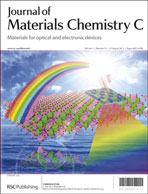Two phases of Ga2S3: promising infrared second-order nonlinear optical materials with very high laser induced damage thresholds†
Abstract
Two phases of Ga2S3 with different space groups Cc and F![[4 with combining macron]](https://www.rsc.org/images/entities/char_0034_0304.gif) 3m were synthesized in pure phase by a facile boron–sulfur–metallic
3m were synthesized in pure phase by a facile boron–sulfur–metallic


 Please wait while we load your content...
Please wait while we load your content...